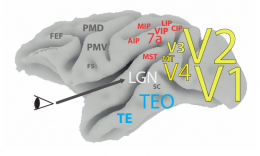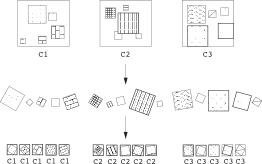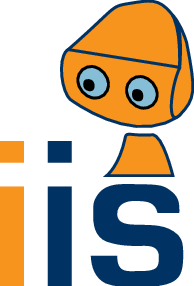Home
People
Projects
Research
Publications
Surveys
Courses
Student Projects
Jobs
Downloads
Sidebar
This is an old revision of the document!
Research
Research at IIS is situated at the intersection of computer vision, machine learning and robotics, and focuses on adaptive perception-action systems as well as on image and video analysis. Some of our areas of activity include
- object models for robotic interaction
- perception for grasping and manipulation
- systems that improve their performance with experience
- video analysis for applications such as sports or human-computer interaction
- links with the psychology and biology of perception
Most of our work is based on probabilistic models and inference.
The following list highlights some examples of our current and past work. Follow the links for more information.
 Computational neuroscience - Due to the complexity of vision tasks for computers, many scientists and engineers have resorted towards neurophysiology for solutions on how the human visual system solves such a difficult tasks with astonishing efficiency and accuracy. Recent approaches to object recognition are mainly driven by the “edge doctrine” of visual processing pioneered by Hubel and Wiesel's work (that led to their 1981 Nobel Prize in Medicine). Edges - as detected by responses of simple and complex cells - provide important information about the presence of shapes in visual scenes. We consider that their detection is only a first step at generating an interpretation of images. Our line of work focuses on intermediate level processing areas, these operate upon initial simple and complex cell outputs towards the formation of neural representations of scene content that allow robust shape inference and object recognition.
Computational neuroscience - Due to the complexity of vision tasks for computers, many scientists and engineers have resorted towards neurophysiology for solutions on how the human visual system solves such a difficult tasks with astonishing efficiency and accuracy. Recent approaches to object recognition are mainly driven by the “edge doctrine” of visual processing pioneered by Hubel and Wiesel's work (that led to their 1981 Nobel Prize in Medicine). Edges - as detected by responses of simple and complex cells - provide important information about the presence of shapes in visual scenes. We consider that their detection is only a first step at generating an interpretation of images. Our line of work focuses on intermediate level processing areas, these operate upon initial simple and complex cell outputs towards the formation of neural representations of scene content that allow robust shape inference and object recognition.
Check our PLOS ONE publications in Rodriguez-Sanchez and Tsotsos (2012) and Azzopardi, Rodriguez-Sanchez, Piater and Petkov (2014).
 Probabilistic models of appearance for object recognition and pose estimation in 2D images - We developed methods to represent the appearance of objects, and associated inference methods to identify them in images of cluttered scenes. The goal here is to leverage, to a maximum, the information conveyed by 2D images alone, without resorting to stereo or other 3D sensing techniques. We are also interested in recovering the precise pose (3D orientation) of objects, so as to ultimately use such information in the context of robotic interaction and grasping.
Probabilistic models of appearance for object recognition and pose estimation in 2D images - We developed methods to represent the appearance of objects, and associated inference methods to identify them in images of cluttered scenes. The goal here is to leverage, to a maximum, the information conveyed by 2D images alone, without resorting to stereo or other 3D sensing techniques. We are also interested in recovering the precise pose (3D orientation) of objects, so as to ultimately use such information in the context of robotic interaction and grasping.
 Grasp Densities: Dense, Probabilistic Grasp Affordance Representations
- Motivated by autonomous robots that need to acquire object manipulation skills on the fly, we are developing methods for representing affordances by nonparametrically by samples from an underlying affordance distribution. We started by representing graspability by distributions of object-relative gripper pose distributions for successful grasps (Detry et al. 2011).
Grasp Densities: Dense, Probabilistic Grasp Affordance Representations
- Motivated by autonomous robots that need to acquire object manipulation skills on the fly, we are developing methods for representing affordances by nonparametrically by samples from an underlying affordance distribution. We started by representing graspability by distributions of object-relative gripper pose distributions for successful grasps (Detry et al. 2011).
 Probabilistic Structural Object Models for Recognition and 3D Pose Estimation - Motivated by automnomous robots that need to acquire object models and manipulation skills on the fly, we developed learnable object models that represent objects as Markov networks, where nodes represent feature types, and arcs represent spatial relations (Detry et al. 2009). These models can handle deformations, occlusion and clutter. Object detection, recognition and pose estimation are solved using classical methods of probabilistic inference.
Probabilistic Structural Object Models for Recognition and 3D Pose Estimation - Motivated by automnomous robots that need to acquire object models and manipulation skills on the fly, we developed learnable object models that represent objects as Markov networks, where nodes represent feature types, and arcs represent spatial relations (Detry et al. 2009). These models can handle deformations, occlusion and clutter. Object detection, recognition and pose estimation are solved using classical methods of probabilistic inference.
 Reinforcement Learning of Visual Classes - Using learning approaches on visual input is a challenge because of the high dimensionality of the raw pixel data. Introducing concepts from appearance-based computer vision to reinforcement learning, our RLVC algorithm (Jodogne & Piater 2007) initially treats the visual input space as a single, perceptually aliased state, which is then iteratively split on local visual features, forming a decision tree. In this way, perceptual learning and policy learning are interleaved, and the system learns to focus its attention on relevant visual features.
Reinforcement Learning of Visual Classes - Using learning approaches on visual input is a challenge because of the high dimensionality of the raw pixel data. Introducing concepts from appearance-based computer vision to reinforcement learning, our RLVC algorithm (Jodogne & Piater 2007) initially treats the visual input space as a single, perceptually aliased state, which is then iteratively split on local visual features, forming a decision tree. In this way, perceptual learning and policy learning are interleaved, and the system learns to focus its attention on relevant visual features.
 Reinforcement Learning of Perception-Action Categories - Our RLJC algorithm (Jodogne & Piater 2006), extends RLVC to the combined perception-action space. This constitutes a promising new approach to the age-old problem of applying reinforcement learning to high-dimensional and/or continuous action spaces.
Reinforcement Learning of Perception-Action Categories - Our RLJC algorithm (Jodogne & Piater 2006), extends RLVC to the combined perception-action space. This constitutes a promising new approach to the age-old problem of applying reinforcement learning to high-dimensional and/or continuous action spaces.
 Image Classification with Extremely Randomized Trees - We developed a generic method that achieves highly competitive results on several, very different data sets (Marée et.al. 2005). It is based on three straightforward insights: randomness to keep classifier bias down, local patches to increase robustness to partial occlusions and global phenomena such as viewpoint changes, and normalization to achieve invariance to various transformations. The key contribution was probably the demonstration of how far randomization can take us: Local patches are extracted at random, rotational invariance is obtained by randomly rotating the training patches, and classification is done using Extremely Randomized Trees.
Image Classification with Extremely Randomized Trees - We developed a generic method that achieves highly competitive results on several, very different data sets (Marée et.al. 2005). It is based on three straightforward insights: randomness to keep classifier bias down, local patches to increase robustness to partial occlusions and global phenomena such as viewpoint changes, and normalization to achieve invariance to various transformations. The key contribution was probably the demonstration of how far randomization can take us: Local patches are extracted at random, rotational invariance is obtained by randomly rotating the training patches, and classification is done using Extremely Randomized Trees.
![]() Real-Time Object Tracking in Complex Scenes - While most work at the time was based on background subtraction, we developed new methods for complex scenes by tracking local features for robustness to occlusions and to background changes, taking spatial coherence into account for robustness to overlapping, similar-looking targets. In the context of soccer, we also developed methods for robust, model-based and model-free, absolute and incremental terrain tracking.
Real-Time Object Tracking in Complex Scenes - While most work at the time was based on background subtraction, we developed new methods for complex scenes by tracking local features for robustness to occlusions and to background changes, taking spatial coherence into account for robustness to overlapping, similar-looking targets. In the context of soccer, we also developed methods for robust, model-based and model-free, absolute and incremental terrain tracking.

